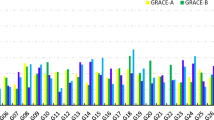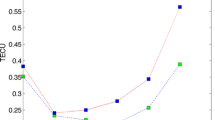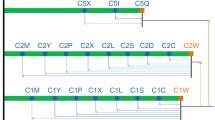Abstract
Many low earth orbit (LEO) missions have been launched recently for different geoscience studying purposes such as ionosphere detecting and gravity recovering. The onboard observations from LEO satellites provide us a great opportunity to estimate the differential code bias (DCB) which is vital for precise applications of global navigation satellites system. This paper mainly focuses on the contribution of multi-LEO combination to the DCB estimation using onboard data collected by current eleven LEO satellites from day of year (DOY) 061, 2018 to DOY 120, 2018. The single-LEO solutions with different LEO and multi-LEO solutions with different LEO subsets are compared and analyzed in detail to fully exploit the potential of LEO onboard observations in the DCB estimation. We also evaluate and discuss the vertical total electron content (VTEC) results and posterior residuals to validate the estimation accuracy. Our results show that the average DCB standard deviation (STD) values are within 0.140 ns for all eleven single-LEO solutions with the best stability of 0.082 ns for Swarm-B solution. The evaluation of multi-LEO solutions indicates that with the increase in LEO satellites, the GPS DCB stability gets improved gradually. The 9-LEO solution can achieve the stability with STD value of 0.051 ns, better than that of DCB products from the German Aerospace Center (DLR) (0.055 ns) but slightly worse than that of DCB products from the Chinese Academy of Sciences (CAS) (0.048 ns). The results suggest that the GPS DCB stability based on the onboard observations of nine LEO satellites can be comparable to the ground-based solution derived from a global ground network with hundreds of stations. The LEO space-borne receiver DCB results illustrate that the inclusion of more LEO satellites can contribute to the stability improvement of receiver DCB. In addition, the VTEC estimation can benefit from the joint processing of multiple LEO observations and achieves a noticeable reduction in the percentage of negative VTEC values. Our results also reveal that the spherical symmetry ionosphere assumption might cause accuracy degradation in the DCB estimation at low latitudes.
















Similar content being viewed by others
Data availability
The LEO satellite onboard GNSS observation data are available publicly from GFZ (ftp://swarm-diss.eo.esa.int/Level1b/Latest_baselines/GPSx_RO), ESA (https://scihub.copernicus.eu/dhus/#/home) and CDAAC (https://cdaac-www.cosmic.ucar.edu/cdaac/rest/tarservice/data). The broadcast ephemeris data of GNSS satellites are from IGS (ftp://cddis.gsfc.nasa.gov/pub/gps/data/campaign/mgex/daily/rinex3; ftp://cddis.gsfc.nasa.gov/pub/gps/data/daily). The DCB products can be downloaded publicly from CAS (ftp://ftp.gipp.org.cn/project/dcb/mgexdcb/), DLR (ftp://cddis.gsfc.nasa.gov/pub/gps/products/mgex/dcb/) and GFZ (ftp://swarm-diss.eo.esa.int/Level2daily/Latest_baselines/TEC). Main results assessed in this manuscript can be accessed from http://igmas.users.sgg.whu.edu.cn/group/tool/9.
References
Aschbacher J, Milagro-Pérez MP (2012) The European Earth monitoring (GMES) programme: status and perspectives. Remote Sens Environ 120:3–8
Bankey V, Anveshkumar N (2015) Design and performance issues of Microstrip antennas. Int J Sci Eng Res 6(3):1572–1580
Blewitt G (1990) An automatic editing algorithm for GPS data. Geophys Res Lett 17(3):199–202
Edwards PG, Berruti B, Blythe P, Callies J, Carlier S, Fransen C, Krutsch R, Lefebvre A-R, Loiselet M, Stricker N (2006) The MetOp satellite—weather information from polar orbit. ESA Bull 127(127):8–17
Feltens J (2003) The activities of the ionosphere working group of the International GPS Service (IGS). GPS Solut 7(1):41–46
Foelsche U, Kirchengast G (2002) A simple ‘“geometric”’ mapping function for the hydrostatic delay at radio frequencies and assessment of its performance. Geophys Res Lett 29(10):1473
Friis-Christensen E, Lühr H, Knudsen D, Haagmans R (2008) Swarm—an Earth observation mission investigating geospace. Adv Space Res 41(1):210–216
Gao S, Clark K, Unwin M, Zackrisson J, Shiroma WA, Akagi JM, Maynard K, Garner P, Boccia L, Amendola G, Massa G, Underwood C, Brenchley M, Pointer M, Sweeting MN (2009) Antennas for modern small satellites. IEEE Antennas Propag Mag 51(4):40–56
Ge Y, Zhou F, Sun B, Wang S, Shi B (2017) The impact of satellite time group delay and inter-frequency differential code bias corrections on multi-GNSS combined positioning. Sensors 17:602
Hackel S, Montenbruck O, Steigenberger P, Balss U, Gisinger C, Eineder M (2016) Model improvements and validation of terrasar-x precise orbit determination. J Geod 91:547–562
Heise S, Jakowski N, Wehrenpfennig A, Reigber Ch, Lühr H (2002) Sounding of the topside ionosphere/plasmasphere based on GPS measurements from CHAMP: initial results. Geophys Res Lett 29:14
Hernández-Pajares M, Juan J, Sanz J (1999) New approaches in global ionospheric determination using ground GPS data. J Atmos Sol Terr Phys 61(16):1237–1247
Hernández-Pajares M, Juan J, Sanz J, Arasgón-Àngel À, García-Rigo A, Salazar D, Escudero M (2011) The ionosphere: effects, GPS modeling and the benefits for space geodetic techniques. J Geod 85:887–907
Hernández-Pajares M, Juan J, Sanz J, Orus R, Garcia-Rigo A, Feltens J, Komjathy A, Schaer S, Krankowski A (2009) The IGS VTEC maps: a reliable source of ionospheric information since 1998. J Geod 83(3):263–275
Hwang C, Tseng TP, Lin TJ, Svehla D, Hugentobler U, Chao BF (2010) Quality assessment of FORMOSAT-3/COSMIC and GRACE GPS observables: analysis of multipath, ionospheric delay and phase residual in orbit determination. GPS Solut 14(1):121–131
Jäggi A, Dach R, Montenbruck O, Hugentobler U, Bock H, Beutler G (2009) Phase center modeling for LEO GPS receiver antennas and its impact on precise orbit determination. J Geod 83(12):1145–1162
Kang Z, Bettadpur S, Nagel P, Save H, Poole S, Pie N (2020) GRACE-FO precise orbit determination and gravity recovery. J Geod 94:85
Lee HB, Jee G, Kim YH, Shim JS (2013) Characteristics of global plasmaspheric TEC in comparison with the ionosphere simultaneously observed by Jason-1 satellite. J Geophys Res Space Phys 118:935–946
Li H, Li B, Lou L, Yang L, Wang J (2016) Impact of GPS differential code bias in dual- and triple-frequency positioning and satellite clock estimation. GPS Solut 21:897–903
Li W, Li M, Shi C, Fang R, Zhao Q, Meng X, Yang G, Bai W (2017) GPS and BeiDou differential code bias estimation using Fengyun-3C satellite onboard GNSS observations. Remote Sens 9(12):1239
Li X, Li X, Yuan Y, Zhang K, Zhang X, Wickert J (2018a) Multi-GNSS phase delay estimation and PPP ambiguity resolution: GPS, BDS, GLONASS. Galileo J Geod 92(6):579–608
Li X, Xie W, Huang J, Ma T, Zhang X, Yuan Y (2018b) Estimation and analysis of differential code biases for BDS3/BDS2 using iGMAS and MGEX observations. J Geod 93(3):419–435
Li X, Ma T, Xie W, Zhang K, Huang J, Ren X (2019a) FY-3D and FY-3C onboard observations for differential code biases estimation. GPS Solut 23:57
Li X, Ma F, Li X, Lv H, Bian L, Jiang Z, Zhang X (2019b) LEO constellation-augmented multi-GNSS for rapid PPP convergence. J Geod 93(5):749–764
Li Z, Yuan Y, Fan L, Huo X, Hsu H (2014) Determination of the differential code bias for current BDS satellites. IEEE Trans Geosci Remote Sens 52(7):3968–3979
Lin J, Yue X, Zhao S (2014) Estimation and analysis of GPS satellite DCB based on LEO observations. GPS Solut 20(2):251–258
Liu M, Yuan Y, Huo X, Li M, Chai Y (2020) Simultaneous estimation of GPS P1–P2 differential code biases using low earth orbit satellites data from two different orbit heights. J Geod 94(12):121
Mannucci AJ, Wilson BD, Yuan DN, Ho CH, Lindqwister UJ, Runge TF (1998) A global mapping technique for GPS-derived ionospheric total electron content measurements. Radio Sci 33(3):565–582
Montenbruck O, Kroes R (2003) In-flight performance analysis of the CHAMP BlackJack GPS receiver. GPS Solut 7(2):74–86
Montenbruck O, Andres Y, Bock H, Helleputte T, Ijssel J, Loiselet M, Marquardt C, Silvestrin P, Visser P, Yoon Y (2008) Tracking and orbit determination performance of the GRAS instrument on MetOp-A. GPS Solut 12:289–299
Montenbruck O, Garcia-Fernandez M, Yoon Y, Schon S, Jaggi A (2009) Antenna phase center calibration for precise positioning of LEO satellites. GPS Solut 13(1):23–34
Montenbruck O, Hauschild A, Steigenberger P (2014) Differential code bias estimation using multi-GNSS observations and global ionosphere maps. Navigation 61(3):191–201
Montenbruck O, Hackel S, Jaggi A (2018) Precise orbit determination of the Sentinel-3A altimetry satellite using ambiguity-fixed GPS carrier phase observations. J Geod 92:711–726
Öhgren M, Bonnedal M, Ingvarson P (2011) GNSS antenna for precise orbit determination including S/C interference predictions. In: European conference on antennas & propagation. IEEE
Noja M, Stolle C, Park J, Lühr H (2013) Long-term analysis of ionospheric polar patches based on champ tec data. Radio Sci 48(3):289–301
Reid TGR, Neish AM,Walter TF, Enge PK (2016) Leveraging commercial broadband LEO constellations for navigation. In: Proceedings of the 29th international technical meeting of the satellite division of the institute of navigation (ION GNSS+2016), Portland, Oregon, September 2016, pp 2300–2314
Sanz J, Juan JM, Rovira-Garcia A, González-Casado G (2017) GPS differential code biases determination: methodology and analysis. GPS Solut 21(4):1549–1561
Schaer S (1999) Mapping and predicting the earth’s ionosphere using the global positioning system. Geod. -Geophys. Arb. Schweiz 59(59)
Tapley BD, Bettadpur S, Watkins M, Reigber C (2004) The gravity recovery and climate experiment: mission overview and early results. Geophys Res Lett 31(9):L09607
Wang N, Yuan Y, Li Z, Montenbruck O, Tan B (2015) Determination of differential code biases with multi-gnss observations. J Geod 90(3):209–228
Wautelet G, Loyer S, Mercier F, Perosanz F (2017) Computation of GPS P1–P2 differential code biases with Jason-2. GPS Solut 21(4):1619–1631
Yuan L, Jin S, Hoque M (2020) Estimation of LEO-GPS receiver differential code bias based on inequality constrained least square and multi-layer mapping function. GPS Solut 24:57
Yue X, Schreiner WS, Lei J, Sokolovskiy SV, Rocken C, Hunt DC, Kuo YH (2010) Error analysis of Abel retrieved electron density profiles from radio occultation measurements. Ann Geophys 28:217–222
Yue X, Schreiner WS, Hunt DC, Rocken C, Kuo YH (2011) Quantitative evaluation of the low earth orbit satellite based slant total electron content determination. Space Weather 9(9):S09001
Zakharenkova I, Cherniak I (2015) How can GOCE and TerraSAR-X contribute to the topside ionosphere and plasmasphere research? Space Weather 13(5):271–285
Zhang X, Tang L (2014) Daily global plasmaspheric maps derived from COSMIC GPS observations. IEEE Trans Geosci Remote Sens 52(10):6040–6046
Zhong J, Lei J, Dou X, Yue X (2016a) Is the long-term variation of the estimated GPS differential code biases associated with ionospheric variability? GPS Solut 20(3):313–319
Zhong J, Lei J, Dou X, Yue X (2016b) Assessment of vertical TEC mapping functions for space-based GNSS observations. GPS Solut 20(3):353–362
Zhong J, Lei J, Dou X, Yue X (2016c) Determination of differential code bias of GNSS receiver onboard low earth orbit satellite. IEEE Trans Geosci Remote Sens 54(8):4896–4905
Zhong J, Lei J, Wang W, Burns AG, Yue X, Dou X (2017) Longitudinal variations of topside ionospheric and plasmaspheric TEC. J Geophys Res Space Phys 122:6737–6760
Zhou P, Nie Z, Xiang Y, Wang J, Du L, Gao Y (2020) Differential code bias estimation based on uncombined PPP with LEO onboard GPS observations. Adv Space Res 65(1):541–551
Acknowledgements
The authors would like to thank ESA, COSMIC Data Analysis and Archive Center (CDAAC) and IGS for providing the free LEO onboard data and the GNSS satellite orbits. Thanks also go to the DLR and the CAS for providing the DCB products. This work has been supported by the National Natural Science Foundation of China under Grant 41774030, Grant 41974027, and Grant 41974029, in part by the Hubei Province Natural Science Foundation of China under Grant 2018CFA081. The numerical calculations have been done on the supercomputing system in the Supercomputing Center of Wuhan University (http://hpc.whu.edu.cn/).
Author information
Authors and Affiliations
Contributions
X. Li, W. Zhang, and K. Zhang designed the research; X. Li and W. Zhang performed the research; X. Li, W. Zhang and K. Zhang wrote the paper; W. Zhang and K. Zhang analyzed the data; Q. Zhang contributed to the paper writing and the data analyzes; X. Li and Z. Jiang provided valuable help during the revision of the paper; Q. Zhang, X. Ren, X. Li, and Y. Yuan gave helpful suggestions during the internal reviewing process.
Corresponding author
Rights and permissions
About this article
Cite this article
Li, X., Zhang, W., Zhang, K. et al. GPS satellite differential code bias estimation with current eleven low earth orbit satellites. J Geod 95, 76 (2021). https://doi.org/10.1007/s00190-021-01536-2
Received:
Accepted:
Published:
DOI: https://doi.org/10.1007/s00190-021-01536-2




